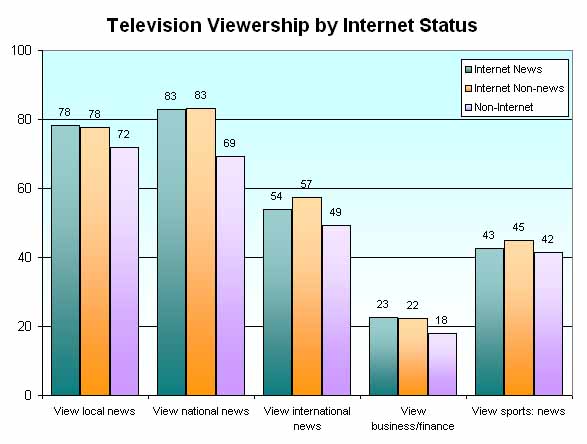
(Source: 2003 TGI Brasil)
The Internet As News Source
Once upon a time, news was distributed by newspapers, as the name would suggest. In time, television came alone and the majority of the population receives its news from that medium. However, both newspapers and television have some drawbacks. Newspapers are typically published once a day or less frequently, and quite often it is necessary to purchase a copy. Television news is delivered during scheduled time periods, and cannot be replayed easily (as in "Oh, you should have seen that news show last night? You'd be sorry if you missed that segment."). Enter the Internet, where there are many news sources that can be retrieved at one's convenience. Will this change how people obtain their news information?
We will cite some survey data from the 2003 TGI Brasil survey. This is a survey of 10,624 persons between the ages of 12 to 64 years old conducted during the year 2003 in Brazil. Within this study, 25.7% of the respondents said that they have used the Internet within the past 7 days. The Internet users are further divided into 6.5% who said completely agree with the statement "When I need information, the first place that I would go to is the Internet" and the other 19.2%.
In the chart below, we show the characteristics of these three groups. For example, the Internet information seekers are distributed among the socio-economic levels as 77% AB, 22% C and 1% DE; the other Internet users are distributed as 67% AB, 28% C and 6% DE; and the non-Internet users as 20% AB, 42% C and 39% DE. As we might expect, the Internet users as a whole are more affluent, influential and educated than the non-users. Within the Internet users, the Internet information seekers have only a slight superiority over the other Internet users.

(Source: 2003 TGI Brasil)
Our interest is to see to what extent the Internet is displacing the traditional news sources. In the following chart, we show newspaper readership figures. There are two points. The Internet users as a whole are more likely to read newspapers than the non-users, and this is consistent with the demographic characteristics. Within the Internet users, newspaper readership is slightly lower among the Internet information seekers than the others. This is therefore suggestive that there is a small shift from newspaper reading to Internet browsing for news and other kinds of information.

(Source: 2003 TGI Brasil)
The next chart shows television viewing to news programs for the three groups. The Internet users are slightly more interested in news than the non-users. Within the Internet users, the differences are slightly significant.

(Source: 2003 TGI Brasil)
Finally, the last chart shows Internet browsing for the three groups. The non-Internet users are defined as those who have not used the Internet within the past 7 days, so a tiny fraction of them do occasionally use the Internet for news and information. Within the Internet users, the information seekers use the Internet significantly more often for news. Beyond the general categories here, we found that such differences exist for the major news portals such as Estado, Globo.com, Terra, UOL and Yahoo!.

(Source: 2003 TGI Brasil)
An interesting point from these data points is that the Internet information seekers are reading less printed newspapers and more online newspapers. Traditionally, the comparagraph of printed and online newspapers are given in a table such as the following:
| Advantages of online newspapers | Disadvantages of online newspapers |
|
|
Of course, the smart newspaper owner would not regarded the online and printed editions of the newspapers as being mutually exclusive. It is a well-known fact that the online reader is more likely to read the print edition. Instead of competing against each other, the online and printed editions compliment each other. If anything, it is much more difficult in this environment to be exclusively online or print.
(posted by Roland Soong, 4/4/2004)
(Return to Zona Latina's Home Page)